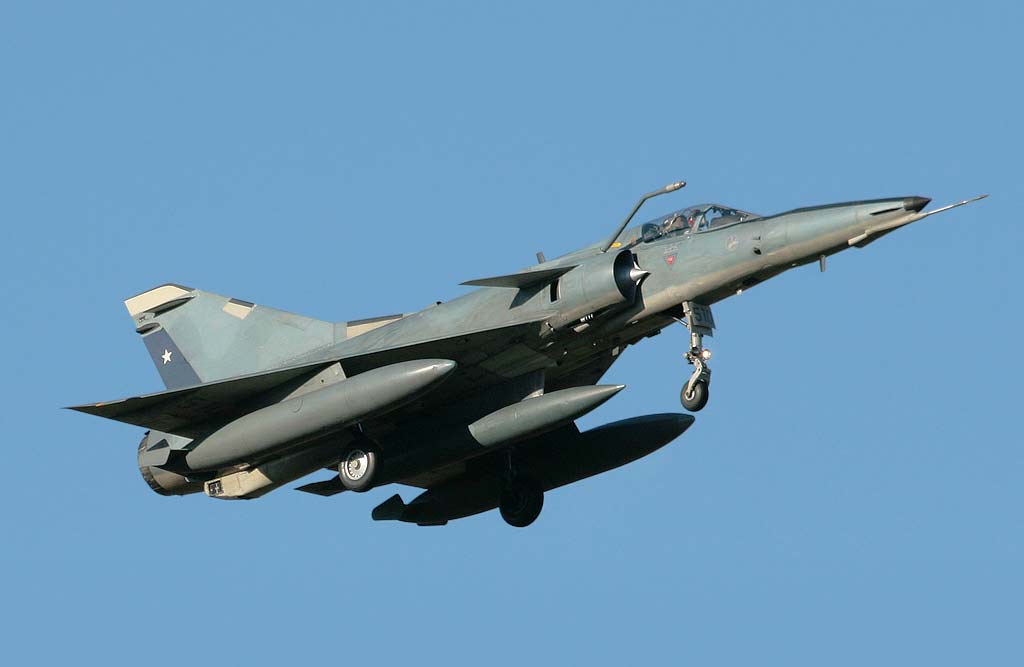The ENAER Mirage 50CN Pantera is a Chilean-upgraded fighter jet with enhanced avionics and capabilities.
In brief
The ENAER Mirage 50CN Pantera is an upgraded variant of the French Dassault Mirage 5, tailored by the Chilean aeronautics company ENAER. The Pantera features improved avionics, a new radar system, and a more powerful engine, along with structural refinements for better performance at higher speeds. This aircraft is equipped for both air-to-air combat and ground attack roles, featuring modern electronic warfare and weapon systems that significantly enhance its operational capabilities.
History of the Development
The Mirage 50CN Pantera’s development marks an era of significant aviation collaboration between France and Chile. Originally, the Mirage 5, developed by Dassault Aviation, was a simplified, ground-attack version of the Mirage III, conceived during the 1960s to meet the Israeli Air Force requirements. Chile expressed interest in these aircraft in the early 1980s due to their proven track record and suitability for diverse operational needs.
The project to develop the Mirage 50CN Pantera was launched by ENAER (Empresa Nacional de Aeronáutica de Chile), with assistance from Dassault and other French companies, to update the existing Mirage fleet. The main objective was to enhance the tactical capabilities of the Chilean Air Force, extending the life of the Mirage 5 by modernizing its avionics and systems to meet contemporary military requirements.
The first flight of a Pantera upgraded aircraft occurred in 1986, marking a significant milestone in Chile’s aviation capabilities. The program did not just aim to retrofit older aircraft but also to incorporate cutting-edge technology and local innovations, allowing Chile to gain greater autonomy over its military hardware.
The Mirage 50CN Pantera does not have a NATO nickname, largely because its use has been confined to Chile and has not been widely adopted by NATO countries.

Design of the ENAER Mirage 50CN Pantera
The design updates of the Mirage 50CN Pantera reflect a significant improvement over its predecessors. Key enhancements include the installation of a more powerful Atar 9K-50 engine, producing 7,200 kgf of thrust, which improves the aircraft’s speed and load-carrying capacity. The aircraft measures approximately 49 feet in length (15 meters) with a wingspan of 27 feet (8.22 meters).
Significant design efforts were also directed towards revamping the avionics suite, which now includes a new radar system capable of tracking and engaging targets at increased distances, an updated navigation system, and modern electronic countermeasures. These improvements make the Pantera more versatile and capable of executing a wide range of missions, from aerial combat to precision ground attacks.
However, despite these advancements, the Mirage 50CN Pantera faced limitations due to its heritage as a 1960s design. Its airframe life and maintenance demand are high, reflecting older generation technology’s typical upkeep challenges. Moreover, as newer aircraft technologies emerged, the Pantera’s relatively limited radar cross-section and conventional control surfaces did not offer the low observability or super-maneuverability of newer fighters.
Performance of the ENAER Mirage 50CN Pantera
The Mirage 50CN Pantera’s performance is characterized by a top speed of Mach 2.2 (1,452 mph or 2,338 km/h) at high altitude, with a service ceiling of 59,000 feet (18,000 meters). The aircraft’s range is about 740 miles (1,190 kilometers), but this can be extended with external fuel tanks or in-air refueling, which the Pantera is capable of handling.
This aircraft competes well in its class, primarily due to the substantial upgrades over the original Mirage 5. When compared to other aircraft of its era like the F-4 Phantom II, the Pantera offers better agility, a smaller radar cross-section, and significantly improved avionics, which makes it a formidable adversary in both air-to-air and air-to-ground missions.
Variants of the ENAER Mirage 50CN Pantera
The Mirage 50CN Pantera itself is an upgrade rather than a stand-alone model, with all units originally retrofitted from existing Mirage 5 airframes. However, within this upgrade program, variations exist primarily in terms of avionics packages, specific weapons integration, and mission capabilities tailored to different operational requirements of the Chilean Air Force.
Military Use and Combat of the ENAER Mirage 50CN Pantera
The Mirage 50CN Pantera has been a crucial part of the Chilean Air Force’s inventory, primarily used for national defense and maintaining air superiority in the region. It has been equipped to carry an array of weaponry, including air-to-air missiles, air-to-ground missiles, and conventional bombs, making it highly effective in a variety of combat scenarios.
The aircraft has seen deployment in numerous training and deterrence missions rather than active combat, reflecting Chile’s strategic use of its air force for defense and sovereignty protection. The Pantera’s capability to engage in both conventional and irregular warfare tasks has been repeatedly demonstrated in joint exercises and in response to potential threats.
Chile has not exported the Mirage 50CN Pantera, maintaining these aircraft for exclusive use within its own armed forces. To date, the Pantera remains in service, although future plans include replacing it with more modern aircraft as part of ongoing modernization efforts within the Chilean Air Force.
–
The ENAER Mirage 50CN Pantera represents a significant evolution in the capabilities of the Chilean Air Force, demonstrating the impact of strategic upgrades on extending the operational life and effectiveness of older aircraft models. Its performance and versatility ensure that it continues to be a valuable asset for national defense.
Back to the Fighter Jet section.